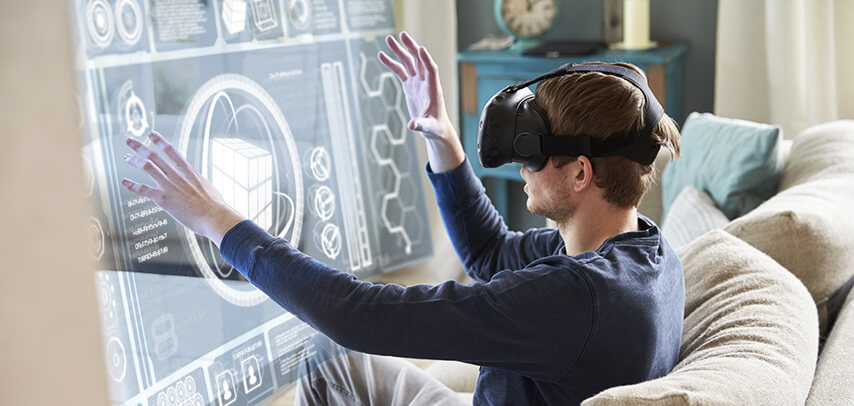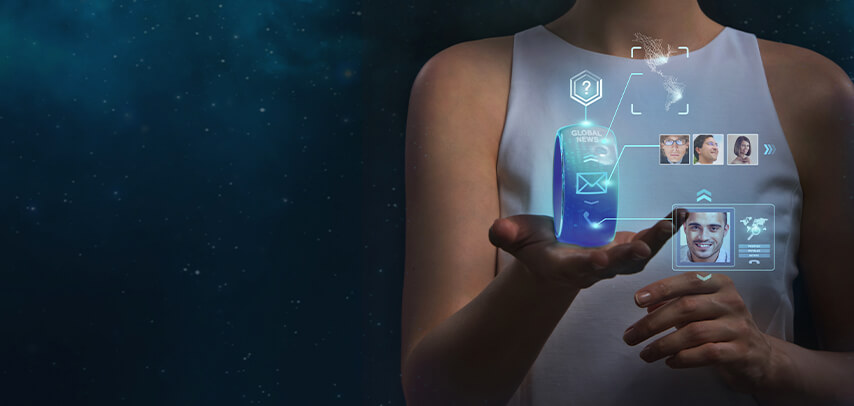Imagine your ring with that amazing precious stone could monitor your activities throughout the day or notify you of the calls and messages you receive on your phone! Or what if you could adjust the volume on your headphones by tapping on your jean jacket... Wearable technologies that we never could have imagined to exist are now becoming indispensable items in our lives. You do not need to be a secret agent to answer your phone through your watch anymore. And with the little devices in your ears able to be activated with a soft touch, you can listen to music with perfect sound quality and answer phone calls.
Our interest in and dependency on devices that can be used independent of location and make our lives easier in many ways, are increasing. This only proves that these products called “wearable technologies” will only undergo further development and become more diverse.
What is Wearable Technology?
Wearable technology refers to technological tools that we can place on our bodies or on our clothes, depending on the design and features of the device. Although the history of wearable technology products goes way back, today’s definition also requires these products to have smart sensors and microchips, and to allow data transfer through a wireless network.
To understand wearable technologies better, we also need to understand the concept of the Internet of Things (IoT). The Internet of Things refers to the communication that takes place between objects connected to a network. This communication is the data transfer that takes place as required by the objects. As a concept that entered our lives in the early 2000s, the Internet of Things continues to develop through its applications in smart cities, smart homes, and wearable technologies.

History of Wearable Technologies
Although the context was different, the history of wearable technologies dates back to the 15th century. The pedometer, first developed by Leonardo da Vinci for military use, was brought to life by Abraham-Louis Perrelet from Switzerland in the 17th century, and it was used to measure distance by calculating the steps taken in a certain amount of time.
In the 16th century, small clocks that could be worn as necklaces were created. Being able to carry clocks around was an innovation in and of itself. When men decided they wanted to carry the clocks in their pockets, instead of around their necks, pocket watches were designed. During the next century, arm watches were developed for women in the shape of bracelets.
In the 17th century, rings that were decorative and could also be used as an abacus, were designed. In the same century, the first hearing aids were developed.
In 1975, watches with calculators were created, and they were considered to be a milestone in wearable technology. These watches became a phenomenon.
After this date, wearable technology developed at a dizzying speed. In 1977, the fingertip heart rate monitors were developed, followed by a portable wireless heartbeat monitor two years later. Then in 1979, Sony Walkman entered our lives and fundamentally changed our music listening habits. In the 80s and 90s, technologies that weaved electronic devices into clothing were developed. In 2000, the first Bluetooth headsets were launched. Then, in 2003, Zephyr developed the Bioharness to monitor the physiological parameters of athletes or people with physically demanding jobs. In 2010, these devices were used to monitor the health conditions of miners who were trapped in a mine in Chile for 69 days.
In 2009, we were introduced to the fitness trackers, also known as smart watches. In 2013, Google launched the controversial Google Glass, in limited edition, bringing “smart glasses” into our lives. In 2015, smart watches became the most valuable commodity of the wearable technology sector. As new devices and apps continue to be introduced every year, we will get to witness how wearable technologies will shape our future.
Why are Wearable Technologies Important?
Although the applications areas of wearable technologies have expanded greatly and have begun transforming the way we do things, particularly in healthcare, as well as in communication, education, entertainment and fashion, they are still in their infancy.
The first wearable technology devices used in healthcare dates back to the pagers that doctors used. However, the devices available today have the potential to change the way doctors and patients communicate. Technologies used by people with chronic illnesses to allow their vitals to be monitored digitally from far away have already begun saving lives, as they notify first responders when patients fall or pass out. Just recently, Mike Jagger, who lives alone, was rescued after his Apple Watch sensed that he fell. Noticing that Jagger was motionless for 45 seconds, the device automatically called 911, ensuring that help would arrive. This is a great example of how the devices we use are transforming our lives. Of course, for your devices to be able to connect to emergency services and get a response, the systems around you need to be compatible with the requirements of this technology

The Future of Wearable Technologies
When we consider the speed at which technology develops, we can say that the possibilities in wearable technology are endless. However, experts believe that the effects of the COVID-19 pandemic on our personal lives will also effect the future of wearable technology.
Currently, many wearable technology devices can measure basic health parameters, such as the pulse and blood pressure. With the pandemic, devices that can monitor the oxygen level in the blood and the body temperature have also gained importance. With the emphasis on health and homelife, it is expected that new interfaces capable of monitoring sleeping patterns and moods, facilitating remote monitoring of the elderly and children, and controlling smart home devices will be added to wearable technologies. Thermometers and blood oxygen saturation monitors have already begun appearing on smart watches that measure a comprehensive array of health parameters. The next major development expected to take place in these devices is contactless payment through NFC.
As more and more innovations enter our lives, we cannot ignore the fact that we consume more and get tired of things easily. Since product developers are aware of this, they are certain that new types of smart devices will be developed, such as smart necklaces and keychains. Actually, these types are already beginning to emerge. There is a new market for wearable technology developing, one that is specifically for women and emphasizes design.
Some of the developments expected in wearable technologies include making them less dependent on mobile phones and giving them a longer battery life. Currently, we can connect our earphones, smart watches and fitness trackers to our phone, but we still need to be within the vicinity of our phones to have access. During the next few years, this dependency on the phone and charging times is expected to decrease.
We also expect that new developments in the recently popularized concepts of “user experience design” and “user interface design” will create much more affordable and user-friendly products in the future.

Most Popular Wearable Technology Products
Smart Watches
As one of the most well-known and commonly used wearable technologies, smart watches allow you to read and respond to the messages you receive on your phone, and to answer phone calls without having to touch your phone. Moreover, smart watches have all the features that fitness trackers have. The design of smart watches is improving and changing every day. The Apple Watch, one of the leading brands in the industry, now allows its users to take an ECG, monitor all their fitness activities and measure their blood oxygen saturation levels. Another device, Matrix PowerWatch, charges using sunlight and body heat.
Fitness Trackers
Fitness trackers, which monitor and record the number of steps we take, our heart rate, the number of calories we burn and other data, are the devices which introduced many of us to wearable technology. Since these trackers focus on functionality, they are more affordable than smart watches. However, with the many features that have recently been added to fitness trackers, the performance and price difference between the two are narrowing. The market leader, Fitbit, has a wide array of products and offers products to children and adults. Garmin Foreruner, especially preferred by runners, and Xiaomi and Huawei brands offer affordable fitness trackers with a good price-performance ratio.
Smart Jewelry
Designed for monitoring physical activity, smart jewelry is a type of wearable technology for people who prefer smaller and more chic solutions, instead of smart watches or fitness trackers. Smart rings developed by Oura and Ringly, are place on the finger like any other ring. Users can monitor all their health data on their smart phones. Oura offers a more subtle design, whereas Ringly has a rich collection of rings and bracelets adorned with semi-precious stones. The interest in smart jewelry has taken motivated many designers to be creative. Currently, there are many designs for smart jewelry including necklaces, broches, bracelets and earrings, and they have various features.
The most unique and durable solution yet has been developed by Joule. Designed as an earring backing, this little fitness tracker fits any earring you choose. At only 1.5 grams, it is also the lightest fitness tracker in the world.
Smart Clothes
Smart clothes offer more variety of options compared to other forms of wearable technology to ease life and track health data. Considered the future of wearable technology, smart clothes offer many options depending on their use. Samsung is one of the brands that is at the forefront of developing smart clothing. Having made many patent applications already, Samsung is expected launch smart shirts that can diagnose respiratory illnesses, smart shoes that track running fitness, as well as smart bags and smart belts. However, you do not need to wait for the patents to be approved to have access to smart clothes!
Manufactured by Wearable X, smart yoga pants called Nadi X, will let you know if you are in an incorrect position by vibrating. Swimsuits developed by Neviano measure UV lights and warn you to get into the shade or to put on some sunscreen. Smart socks developed for diabetes patients by Siren continuously monitor the legs and notify the user if there are areas that are warming up and becoming prone to inflammation. The goal is to prevent diabetic foot ulcers.
Virtual Reality (VR) Headsets
VR headsets are wearable technology devices that can be used professionally, for simulation training, or for entertainment, and these headsets combine visual and audio systems. We have witnessed the development of these products for years, and their latest lightweight, ergonomic and affordable models make them very popular. VR headsets come in two types: PC supported, or mobile phone supported. Occulus Quest 2 and HTC Vive are some of the prominent computer-supported models that have all the necessary components.
Google Cardboard, a mobile phone supported VR platform is the most interesting example of VR goggles, and it proves that technology can become a part of our daily lives through simple solutions. Made of a foldable cardboard, Google Cardboard allows you to watch VR applications on your cell phone.
Smart Glasses
Glasses, which we typically use for correcting our eyesight, might become the most popular wearable technology items in the near future. The idea of incorporating technology into eye wear came about in 2013 by Google Glass Explorer and have become more common using augmented reality (AR) add-ons, used in a variety of areas including technical support operations to training. Google Glass did not stay in the market for too long due to privacy concerns and a high price tag, but it led the way for other initiatives including Jins Meme, Meta Pro and Wise Up.
Developed by Facebook and the Luxottica Group, owner of Ray-Ban, smart glasses brand Orion is expected to be launched sometime between 2023 and 2025, and to have augmented reality features that can be controlled by a digital assistant, like Siri.
You May Be Also Interested